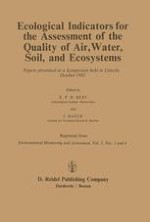1983 | OriginalPaper | Chapter
Zooplankton and its Grazing as Indicators of Trophic Status in Dutch Lakes
Author : R. D. Gulati
Published in: Ecological Indicators for the Assessment of the Quality of Air, Water, Soil, and Ecosystems
Publisher: Springer Netherlands
Included in: Professional Book Archive
Activate our intelligent search to find suitable subject content or patents.
Select sections of text to find matching patents with Artificial Intelligence. powered by
Select sections of text to find additional relevant content using AI-assisted search. powered by
The existing data on the species composition of Zooplankton and grazing intensities of crustacean plankton are discussed in the light of trophic status, particularly in the Dutch lakes of varying trophy. Several species of rotifers in northern Europe and North America are considered to indicate eutrophic environments. However, unanimity is less regarding crustacean Zooplankton, since several species are encountered in lakes varying widely in trophic degree.The Zooplankton to seston (33 μm) biomass ratio may provide information about the ecological transfer efficiency and trophic status. In the Dutch lakes the ratio decreases sharply with increase in food concentration during eutrophication, namely from ca 0.4 in oligotrophic lakes to about 0.05 in the hypertrophic ones.The Zooplankton community grazing is high and variable in lakes of low trophy but low and relatively constant in lakes of high trophy. The fluctuations in the filtering rates of Daphnia sp. (e.g. D. magna) may provide information both on trophic degree as well as dissolved substances in lake waters. The dominance of small cladocerans in lakes may be due to quality of food and trophic level, besides fish predation. The recurrent clear-water phase in lakes would indicate oligo-mesotrophic situations in which the Zooplankton plays an important role in the phytoplankton wax and wane.
